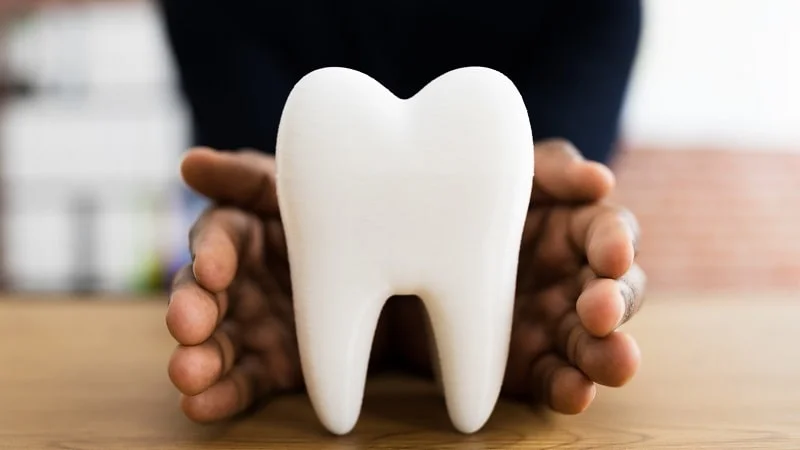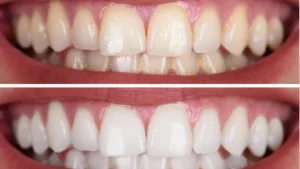Enamel, the protective layer covering our teeth, is like a shield guarding against dental troubles. Yet, due to various factors like our diet and oral habits, this armor can erode, causing enamel loss. This isn’t just about appearance; it affects our dental health too. That’s where “Dental Bonding for Enamel Loss” steps in.
This process involves using a special material to mend those weakened teeth, enhancing their strength and bringing back their natural look. Imagine it as a skilled repair for your smile. So, let’s uncover how dental bonding can restore both your teeth’s strength and your confidence.
What is Enamel?
Enamel is the tough shell covering the visible part of teeth. It’s stronger than bone and protects teeth from daily wear and tear.
Common Causes of Enamel Loss
- Acidic Foods and Drinks: Consuming items like citrus fruits, sodas, and sugary snacks can weaken enamel.
- Poor Oral Hygiene: Inadequate brushing and flossing can lead to plaque buildup, eroding enamel.
- Teeth Grinding: Grinding wears down enamel over time, making teeth more vulnerable.
- Medical Conditions: Certain health issues or medications can contribute to enamel erosion.
Read Also: How Long Does a Dental Cleaning Take?

Consequences of Enamel Loss
Enamel loss isn’t just about appearance. It has practical consequences for oral health.
- Tooth Sensitivity: Weakened enamel exposes sensitive inner layers, causing discomfort.
- Discoloration: Enamel loss can lead to teeth looking yellow or dull.
- Increased Decay Risk: Without enamel protection, teeth are more susceptible to cavities.
Dental Bonding for Enamel Loss
When enamel loss occurs, dental bonding comes to the rescue as a solution to restore both the strength and appearance of your teeth. Let’s dive into how dental bonding works and why it’s a valuable option.
How Dental Bonding Works
- Composite Resin Material: Dental bonding involves using a special material called composite resin. This material is pliable and matches the color of your natural teeth.
- Preparation: The dentist starts by preparing the tooth surface. This usually involves roughening the surface slightly and applying a conditioning liquid.
- Application: The dentist applies the composite resin to the prepared tooth, shaping it to match the natural contours.
- Shaping and Curing: After shaping the resin to the desired form, a curing light is used. This light hardens the resin, bonding it securely to the tooth.
Suitable Cases for Dental Bonding
Dental bonding works best for mild to moderate enamel loss. It’s also effective for improving the appearance of teeth with minor imperfections.
Benefits of Dental Bonding
- Preservation of Tooth Structure: Unlike some other treatments, bonding requires minimal removal of the original tooth structure.
- Improved Aesthetics: Dental bonding restores the natural look of teeth, concealing discoloration and restoring symmetry.
- Protection Against Sensitivity and Decay: The bonded resin acts as a barrier against sensitivity and reduces the risk of decay.
Read Also: Is Dental Cleaning After Every 3 Months Necessary?
The Dental Bonding Procedure
The dental bonding procedure is a straightforward and effective way to restore teeth affected by enamel loss. Let’s explore the step-by-step process of how dental bonding is performed.
Consultation and Examination
- Discussion: Your dentist will discuss your concerns and examine your teeth to determine if dental bonding is suitable for your case.
- Color Matching: The dentist will also match the shade of the composite resin to your natural tooth color for a seamless result.

Tooth Preparation and Isolation
- Tooth Cleaning: The tooth to be bonded is cleaned thoroughly to ensure proper adhesion.
- Conditioning: A conditioning liquid is applied to the tooth. This helps the resin adhere better.
- Resin Application: The dentist applies the putty-like composite resin onto the tooth’s surface.
Application of Composite Resin
- Shaping and Molding: The dentist sculpts the resin to the desired shape, carefully mimicking the natural contours of the tooth.
- Aesthetic Touches: During shaping, the dentist ensures that the resin blends seamlessly with the surrounding teeth.
Curing and Polishing
- Curing: A special curing light is used to harden the resin. This light activates a chemical reaction in the resin, making it durable and sturdy.
- Polishing: After curing, the dentist polishes the bonded tooth to achieve a smooth and natural-looking finish.
Final Adjustments and Evaluation
- Bite Check: The dentist checks your bite to ensure that the bonded tooth aligns properly with your other teeth.
- Comfort Assessment: You’ll be asked about comfort and fit to make sure the bonded tooth feels natural.
Read Also: What Should be the Age For First Dental Cleaning?
Aftercare and Maintenance
Taking care of your bonded teeth after the dental bonding procedure is crucial to ensure their longevity and continued health. Let’s explore the steps you can take to maintain your newly restored smile.
Tips for Maintaining Bonded Teeth
- Oral Hygiene: Continue with regular brushing and flossing to keep your teeth and bonded areas clean.
- Gentle Cleaning: Use a soft-bristle toothbrush to avoid scratching the bonded surface.
- Avoid Staining Substances: Limit consumption of staining foods and drinks like coffee, tea, and red wine to prevent discoloration.
Oral Hygiene Practices
- Fluoride Toothpaste: Use fluoride toothpaste to strengthen enamel and protect against decay.
- Avoid Abrasive Toothpaste: Steer clear of abrasive toothpaste, as it can scratch the bonding material.
Regular Dental Check-ups
- Scheduled Visits: Visit your dentist for regular check-ups and cleanings to ensure the bonded teeth remain in optimal condition.
- Professional Polish: During dental visits, the dentist can professionally polish the bonded teeth to maintain their shine.
Handling Sensitivity
- Temporary Sensitivity: It’s normal to experience some sensitivity after the procedure. This usually subsides within a few days.
- Sensitive Toothpaste: If sensitivity persists, your dentist may recommend using a toothpaste designed for sensitive teeth.
Conclusion
In the realm of dental health, enamel loss is a concern that goes beyond aesthetics, impacting the strength and function of our teeth.
Dental bonding emerges as a versatile solution, capable of addressing enamel loss while restoring both the appearance and structural integrity of the teeth.
By understanding the causes, process, and benefits of dental bonding, individuals can make informed decisions about their oral health.
The composite resin material used in bonding serves as a durable shield, protecting against sensitivity and decay.
With proper aftercare and regular dental visits, the results can be sustained for an extended period, offering a cost-effective and efficient solution to enamel loss.
FAQs (Frequently Asked Questions)
Is dental bonding suitable for severe enamel loss?
Answer: Dental bonding is best suited for mild to moderate enamel loss. Severe cases may require more comprehensive treatments such as veneers or crowns.
Will dental bonding change the color of my teeth?
Answer: Dental bonding can match the color of your natural teeth, restoring a seamless appearance.
Is dental bonding a painful procedure?
Answer: Dental bonding is typically painless. Local anesthesia may be used if necessary to ensure comfort during the procedure.
Can I eat normally after dental bonding?
Answer: Yes, you can eat normally after dental bonding. However, it’s recommended to avoid very hard or sticky foods that could potentially damage the bonded area.
How long does dental bonding last?
Answer: With proper care, dental bonding can last around 5 to 10 years. Regular dental check-ups can help monitor the condition of the bonded teeth.
Can I whiten bonded teeth?
Answer: Dental bonding material does not respond to teeth whitening treatments. If you’re considering teeth whitening, it’s recommended to do so before the bonding procedure.
Is dental bonding reversible?
Answer: Dental bonding is not reversible, as a small amount of enamel might be removed during the preparation process.
Can I have multiple teeth bonded at once?
Answer: Yes, multiple teeth can be bonded in a single session, depending on the extent of treatment needed.
How much does dental bonding cost?
Answer: The cost of dental bonding varies based on factors such as the number of teeth being treated and the location of the dental practice. Consultation with your dentist will provide a more accurate estimate.
References
- Jokstad A, Mjör IA. Enamel and dentin: fundamental concepts of tooth preparation. Eur J Prosthodont Restor Dent. 2014;22(4):177-183.
- Loguercio AD, et al. Current concepts for dental adhesion: Molecular basis and clinical relevance. Oper Dent. 2013;38(3):90-100.
- Freilich MA, et al. Dental ceramics: What is this stuff anyway? J Prosthodont. 2010;19(5):423-434.
- Powers JM, O’Keefe KL. Dental materials: properties and manipulation. Elsevier Health Sciences; 2015.
- Ibarra G, et al. The evolution of dental bonding agents. Pract Proced Aesthet Dent. 2001;13(9):749-756.
- Peumans M, et al. Clinical effectiveness of contemporary adhesives: A systematic review of current clinical trials. Dent Mater. 2005;21(9):864-881.



